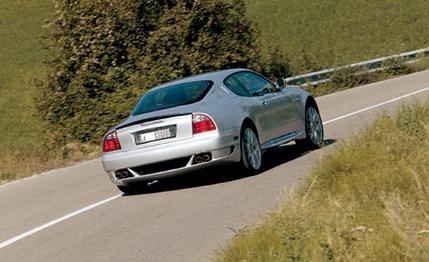 First Drive Review
First Drive Review
It's a familiar formula these days: Take an already exotic $100,000 machine (specifically, in this case, $98,172), simplify the interior, improve the aerodynamics, stiffen the suspension, and add a little more power. The result is promoted as a "more focused" sports car. What's trying to be conveyed is the direct link between the model you drive and those that are raced, an association for which you would be prepared to pay more.
Pioneers of this strategy are the Ferrari Challenge Stradale and the Porsche 911 GT3, and it would seem they are now to be joined by the Maserati GranSport you see here. There is, after all, a racing series for Maseratis (the Trofeo) for gentleman (and gentlewoman) racers, very much like the Ferrari Challenge in the U.S.
All very well, but Maserati R&D chief Roberto Corradi quashes the notion: "No, the GranSport is not a street-legal race car."
After a few hot laps on the Varano de' Melegari race circuit near Parma, Italy, we had to agree. The GranSport was fast in a straight line, stopped well, and swept through the bends with confidence, but it lacked the sharpness of a proper track car. On the road, though, twisting through the gentle hills of Lombardy, the GranSport (in U.S. specification) felt just right: tauter than a regular Maserati Coupé but still reasonably compliant over bumps, more responsive but not uncomfortably aggressive. In short, the best yet of this generation of Maseratis.
The starting point for the modern GranSport is the Coupé Cambiocorsa, which appeared in its current form, with a 4.2-liter V-8 engine and a transaxle incorporating a paddle-shift automated six-speed manual transmission, in 2002. The engine, which is related to the 4.3-liter V-8 in the upcoming Ferrari F430, is "blueprinted"-built with selected components to finer tolerances than the standard Maserati-and has a different exhaust system and inlet manifolds. The result is an 11-hp increase, to 396, although with rather different power and torque curves than the 394-hp version of the same engine in the Maserati Quattroporte sedan. And taking a cue from Ferrari, the exhaust system has a pneumatic valve to reduce back pressure and make a gloriously rich sound when the "sport" button is pressed.
Every successive version of the Cambiocorsa electrohydraulic shift system is a little bit better than the previous one. Maserati says the GranSport has specially developed software that makes shifting in sport mode 35 percent faster than before. We found that admirable-and not as brutal as the Ferrari's F1 shift. The transmission has a four-percent-longer top gear than the Coupé's, which, according to Maserati, enables a claimed 180-mph top speed. The 0-to-62-mph time should be about 4.9 seconds.
The keen driver is more likely to appreciate the difference made by lowering the ride height by 0.4 inch, fitting 19-inch Trofeo wheels with special Pirelli P Zero Rosso Asimmetrico tires, and adding the instantly adaptive Skyhook active damping system, which is standard on the GranSport. Maserati is proud of the aerodynamic improvements, which we suspect were an unexpected bonus from features developed by Ferrari-Maserati design chief Frank Stephenson to give the GranSport a lower look and more muscular stance than the original that was designed by Giugiaro. The visual tricks work-in front with the larger chrome mesh grille and under-bumper air intakes, and in the doorsill extensions, which, close up, look big enough to be running boards. Combined with a trunklid spoiler and an extended rear bumper with enlarged outlets to encourage airflow under the car, the drag coefficient has been improved from 0.34 to 0.33, and the front-to-rear aerodynamic balance is also better.
Despite its extra appendages, we think the GranSport looks good. Inside it does not lose any of its four-seat accommodation, but the décor tries hard to be modern sporty instead of leather-bound traditional. Perhaps it tries too hard. A neat carbon-fiber molding that forms a narrow center console is fine. But then, at a fashion show, Stephenson found some fabric in silver, silver and black, and pale blue that was being promoted for high-tech sports clothing. The various schemes are applied all over the GranSport's cockpit-across the fascia, on the door panels, in the centers of the excellently shaped sport seats, and even up in the headliner. In silver, it is like climbing into a fireman's protective suit.
The GranSport retains the electric seats and all the other features and equipment of the Coupé, save for the full-color display screen that didn't fit in the slimmed-down dash. This does, however, position the important driving controls close to hand: the engine starter; the "sport" button that changes the damper program, gearshift characteristics, accelerator response, and intervention of stability controls; and the switch that turns off the traction control. You will want to use that on a track, but on the road with "sport" selected, you can appreciate its high threshold of operation, allowing the enthusiastic driver to handle a touch of "attitude" before safety reins him in.
It's a good compromise for road use, and that is what the Maserati GranSport is intended for. As Corradi said, this is not a street-legal race car-and it is all the better for that.